The ankle joint is often injured because of heavy loads. Your doctor can diagnose ankle arthritis based on your symptoms and prescribe treatment. The disease does not depend on age and gender, tissues become thin and destroyed, which can lead to disability.
Arthritis affects up to 12% of residents and it most commonly affects women of retirement age.
As mentioned, the ankle can withstand very large loads. It keeps the body upright and allows a person to move. Its violation changes the usual way of life.
Ankle arthritis (symptoms and treatment may vary) is a chronic disease in which irreversible processes occur in the cartilage.
The disease occurs gradually. A healthy person has smooth joint surfaces. When overloaded, it promotes easy slipping during physical activity.
With arthritis, tissue nutrition and metabolism worsen. The outer surface of the joint changes, becomes rough, touches the cartilage and inflammation appears. When a person lifts heavy objects, the load falls on the bones, leading to degenerative disorders.
If treatment is not started, serious pathologies will develop. In later stages, cartilage and tissue are affected, the synovial membrane is irritated, and the joint loses stability. In this case, the support function is affected, movement becomes difficult.
Types
There are several types of joint diseases depending on different criteria:
- cause of occurrence (main, secondary);
- stages of joint disease;
- pathological localization;
- forms of localization (general and local);
- progression of the disease (acute and chronic).
| Classification criteria | Types of joint diseases |
|---|---|
| place of expression | knee, wrist, ankle, elbow, shoulder and cervical joints. |
| cause occurs |
|
| localization |
|
| progression of the disease |
|
Ankle arthritis is divided into primary (degenerative process begins in healthy cartilage due to excessive physical activity) and secondary (destructive diagnosis, appearance of dystrophic changes in cartilage tissue).
Stages and levels
Ankle arthritis (symptoms and treatment depend directly on the patient's age) can occur in different ways. For some people, it takes years from the first symptoms to the critical stage, while for others, the disease develops rapidly.
It depends on age and comorbidities at the start of treatment. As ankle arthritis progresses, symptoms become more pronounced.
There are 4 stages of the disease.
- The first stage is often overlooked. Main symptoms: stiffness in the morning, characteristic crunching sound when walking. Pathogenic changes are not revealed in the image, the destructive process has already begun.
- Morning stiffness continues to last longer. It will take 20-30 minutes to develop legs. Some patients have lameness. On X-rays, you can see stage 2 pathology by bone growth and bone displacement.
- In stage 3, symptoms become more pronounced. The feeling of pain appears in a calm state, the patient cannot do without painkillers. Lameness becomes noticeable and crutches are sometimes required. Joints swell, change, muscles become thinner and reduce in volume. The joint space narrows, as can be seen on X-rays, and bone spurs form.
- The final stage develops if left untreated. Cartilage is destroyed, the surfaces of the joints grow together. The patient cannot walk.
There are several degrees of arthritis:
- First level– X-rays did not show any changes or joints. There is mild stiffness in the morning. At this stage it is necessary to begin treatment.
- At the second levelActivities become difficult, when walking, you hear crunching sounds and swelling. X-rays show a decrease in the space between joints. Limping and morning stiffness last longer.
- At the third levelMarked necrosis and joint deformity. The muscles atrophy more and more, and movement becomes limited. Constant rest is required. The pain does not go away even in this state.
- At the last levelIn fact, without common space, activities are almost impossible. X-rays allow you to diagnose a large number of osteoporosis. Only surgical intervention is prescribed.
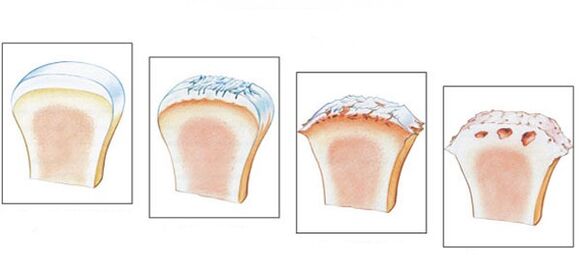
Ankle arthritis appears gradually, so treatment should begin when symptoms first appear to prevent the condition from getting worse and complications occurring.
Symptom
Ankle arthritis is characterized by several symptoms (they influence the treatment method):
- The initial pain is moderate and occurs only with physical activity. Over time, the pain becomes stronger and makes it uncomfortable to rest;
- with wounds and dislocations, swelling and inflammation appear, and the temperature in the injured area increases;
- "dry" clicking sound accompanied by pain;
- Dislocation, when the cartilage tissue becomes thinner and degenerates, the joint loses stability. Bones are displaced and fall out of the joint capsule;
- stiffness;
- When walking, people quickly tire;
- In the final stage, the joint becomes deformed.
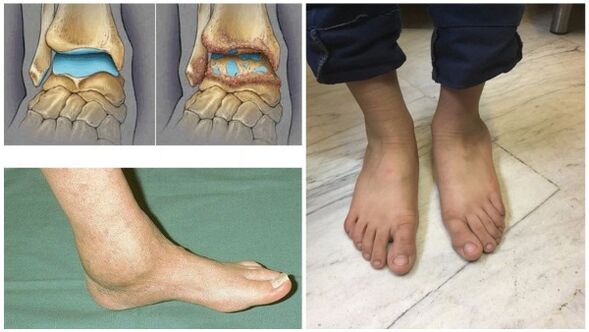
If at least one symptom occurs, you should immediately consult a doctor.
The reason appeared
Ankle arthritis (symptoms and treatment are often due to age-related changes) affects the older generation. Recently, the pathology has been observed in young people.
The stimulating factors are:
- injuries, dislocations and bruises;
- age-related disorders of joints and ligaments;
- inflammatory process;
- overweight;
- violation of metabolic processes;
- Congenital foot deformities and flat feet arise during life;
- genetic predisposition;
- excessive physical activity;
- use uncomfortable shoes;
- diseases of the endocrine system;
- osteoarthritis.

Less synovial fluid is produced, causing less nourishment for the cartilage. The joint space narrows, which can lead to bone fusion. Crusarthrosis occurs, which cannot be reversed. However, immediate treatment is required to stop the progression of the disease.
Diagnose
Diagnosis of joint diseases includes the study of existing symptoms and data obtained from research. Because no test can clearly identify the pathology, doctors find laboratory methods insufficient.
During remission, all indicators were normal; During relapse, blood tests show increased levels of ESR and c-reactive protein. This means that pathology has begun.
To confirm the diagnosis, instrumental methods are used:
- SimpleX-rayis the most reliable method. Muscles do not perceive X-rays equally: soft muscles transmit them, while hard muscles absorb them. This study reveals the disease itself and its consequences.
Imaging allows you to analyze the condition of the bone surfaces in the joint, the shape, size and position of the structures relative to each other, the condition of the tissue and the size of the joint space. Thanks to this data, the degree of pathology can be determined.
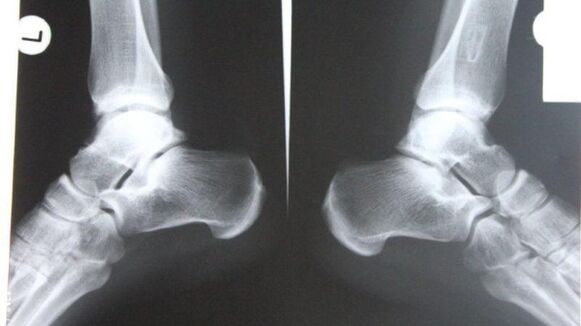
If the ankle is affected, the diagnosis is made in lateral, posterior, and posterior projections with the foot moved medially. If there are corresponding symptoms (narrowing of the joint space, bone spurs and other signs), the diagnosis is arthropathy.
- Benefit from nuclearDetermine the disruption of hydrogen molecules under the influence of a strong magnetic field. Allows you to explore areas of the body that contain water.
The dark colors in the image represent bones because their water content is much less and the muscles, nerves and discs appear lighter. Diagnosis reveals even minor disorders in bone and joint tissue. The procedure is indicated before joint replacement. The only negative is the high cost of diagnostics.
- Magnetic resonance imagingVery precise examination of the ligamentous structure of the joints, muscle tissue and cartilage. Thanks to this research, specialists can evaluate the condition of the joints in the lower legs, thereby determining the pathology at the very beginning of its development. The procedure is painless and lasts about 30 minutes.
During the process, radio waves and strong magnetic field radiation will affect humans. It must be remembered that magnetic fields are harmful to the physiological state. MRI is prohibited in case of neuropsychiatric disorders, pregnancy and the presence of metal objects in the body.
- Supersonicallows for accurate diagnosis. The device generates waves reflected from tissues and recorded on a screen. The doctor examines the image and makes a diagnosis. For clear images, a gel is used to remove air and ensure easy movement across the surface.
The advantages of this procedure are that it is safe for health, affordable and highly accurate.
- Bone scan– a study that helps identify pathological bone disorders using isotopes. A special substance containing labeled atoms is injected into the patient's body. Pathological areas are divided into cold and hot.
First without isotopes, blood flow to them is poorer and they are not detected during the scan. This includes places where melanoma has appeared. In high-temperature regions, isotopes are collected more actively and are clearly detected during scanning. These areas indicate the presence of an inflammatory process.
This study helps to distinguish arthrosis from similar diseases with similar clinical signs. Based on the results, the doctor gives a prognosis and prescribes treatment.
The main contraindications for the study are pregnancy, breastfeeding and taking drugs containing barium.
- Joint punctureis a procedure where the doctor inserts a needle into the joint cavity to remove joint fluid for analysis.
This biological material continues to be studied in the future. Based on the results, specialists determine the characteristic features of the disease and at what stage of development. For ankle arthritis, a puncture is made anteriorly between the lateral ankle and the extensor digitorum longus tendon.
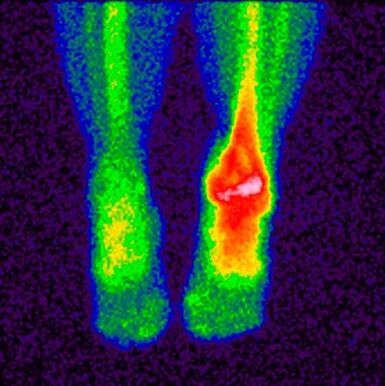
When to see a doctor
If treatment of joint disease is not started promptly, there will be loss of ability to work and sometimes disability. Some patients are in no hurry to seek help because they don't know which doctor to make an appointment with. At the first symptoms, you need to see a rheumatologist to diagnose dystrophic and inflammatory changes in the joints.
You should contact him if:
- there is a feeling of discomfort and joint pain after overwork at the end of the working day;
- it is difficult to find a comfortable position for your feet at night;
- swollen joints, red skin;
- feeling of sharp pain and difficulty moving;
- crunching and clicking sounds appear;
- deformed joints.
With the help of modern diagnostic and treatment techniques, it is possible to avoid surgical intervention and preserve joint function.
Prevent
Ankle osteoarthritis can be prevented (symptoms and treatment can be checked by your doctor).
To prevent joint disease, experts recommend following certain rules:
- wear comfortable, well-fitting shoes without heels;
- Maintain proper nutrition, drink enough clean water;
- choose the right vitamin and mineral complex;
- exercise;
- take walks in the fresh air more often;
- avoid excessive tension in the legs;
- avoid hypothermia;
- be monitored regularly by a doctor;
- give up bad habits;
- Do some exercises to warm up your ankle joint.

It is especially important to adjust your diet. Nutritionists have agreed on a menu that will help prevent the condition from getting worse and provide the body with the necessary substances.
- You need to eat regularly and divide it into small portions.
- Drink at least 2 liters of clean water.
- Avoid sweet and salty foods.
- Don't eat food 4 hours before going to bed.
- Steam, grill, boil food.
Fasting and strict diets for arthritis are strictly prohibited to prevent the excretion of calcium necessary for bone and cartilage repair.
Treatments
Once the diagnosis is confirmed, treatment must begin immediately. It is impossible to completely get rid of arthritis, the main thing is to slow down the process of destruction and increase the period of remission. Many different techniques are used for this purpose.
Medicine
Different drugs are used to treat arthritis:
- Anti-inflammatoryand analgesics eliminate the source of inflammation and relieve pain. Tablets and ointments are used. The sooner you take anti-inflammatory medication, the better your chances of saving your joint.
- Glucocorticoidsused if the above medications do not yield the desired results. They are produced in the form of injectable solutions and injected into the joints.
- Chondroprotectorsneeded to slow down the process of cartilage destruction.
Treatment regimens and medication dosages are prescribed by your doctor based on the severity of your symptoms, comorbidities, and other factors. Self-medication is strictly prohibited so as not to aggravate the situation.
Traditional method
Regarding traditional methods of treating joint diseases, doctors recognize their useful properties and positive effects. Traditional medicine is also used as a method of disease prevention.
The main recipes for the treatment of ankle arthritis are as follows:
- Burdock leaves are thoroughly washed and gently applied to the skin. The plant is fixed with tape or cling film and left overnight.
- Heat sea salt (buckwheat, sand) in a frying pan, pour it into a piece of linen and apply it to the sore spot. Keep until the salt cools. This is an effective way to relieve pain.
- Pour three times the perfume on the lilac, leave it in a dark place for 2 weeks, rub the sore spot twice a day.
- Grind eggshells into powder, take 0. 5 teaspoon. before meal.
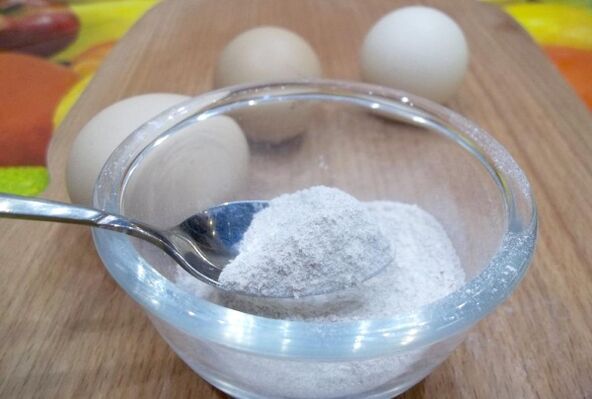
The use of traditional methods of treatment must be approved by the attending physician. This is not the only measure, but an addition to the main therapy.
Other methods
When conservative therapy does not bring a positive effect, they have to resort to radical measures - surgery.
In principle, indications for surgery are:
- Repetitive and primary arthritis 3-4 degrees;
- symptoms;
- severe and prolonged pain radiating down to the knee;
- obvious lameness;
- paralysis of leg muscles;
- deterioration of the flexion-extension properties of the joint and the support capacity of the foot.
For arthritis of the foot, the following surgical interventions are used:
- Arthritis– Joint fixation surgery. Its task is to restore the ability to support the lost limb. The main disadvantage is that the bones easily stick together, leading to immobility, so they are rarely used.
- arthroscopyis a minimally invasive procedure in which the doctor cuts the joint and inserts an arthroscope. The surgeon conducts a visual inspection and evaluates the condition of the intra-articular structures, and if necessary, removes parts of the damaged joint or blood clots from the synovial fluid. With this surgery the risk of recurrence is too high.
- Endoscopiccarried out in particularly serious cases. Helps replace partially or completely damaged joints. Prosthetics with modern mechanics are used and have a lifespan of up to 20 years.
The main contraindications to surgery are under 12 years of age, joint fistula, diabetes, cardiac dysfunction and infectious diseases.
Complications may occur
If treatment is delayed or absent, the following complications may occur:
- disabilities;
- irreversible deformation;
- inactivity and immobility of the joints;
- decline in quality and standard of living.
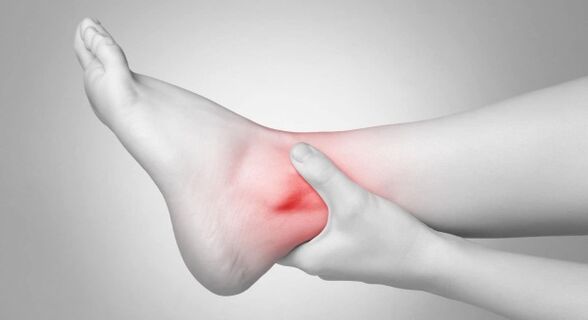
In addition to these complications, the chronic course of the disease is accompanied by pain, discomfort and the inability to lead an active lifestyle.
To make gymnastics, medication and folk treatment more effective, it is recommended to use special orthopedic devices that reduce the load on the joints. This includes orthotics and immobilizers.
The orthosis perfectly follows the contour of the ankle, increasing range of motion and reducing swelling and pain. A bandage has the same effect as an orthopedic device. It is made of soft elastic fabric that allows you to fix your joints well. Bandages are used only during remission, when the exacerbation has passed.
Ankle arthritis is a serious disease that, if not completely treated, will lead to severe consequences and completely immobilize the joint. Diagnosis at an early stage, careful attention to symptoms, and appropriate therapy help avoid surgical intervention.







































